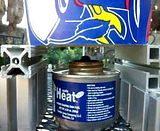The only variable I planned to change was painting the kettle bottom black. I thought that was fairly clear from the start. Obviously, there is no way that as a DIY'er that I can have absolute control over every tiny little variable, but as I mentioned earlier, I'm looking for an appreciable gain and the small variances should not much affect the results. I would expect some variation in the results if multiple tests were run, but I doubt they would amount to much at all. Some over and unders would indicate to me that the blackened bottom would make very little difference. I want to see a significant gain to make it worth the bother. I would not be very impressed with a gain of only a couple of minutes.




















![Craft A Brew - Safale S-04 Dry Yeast - Fermentis - English Ale Dry Yeast - For English and American Ales and Hard Apple Ciders - Ingredients for Home Brewing - Beer Making Supplies - [1 Pack]](https://m.media-amazon.com/images/I/41fVGNh6JfL._SL500_.jpg)





































